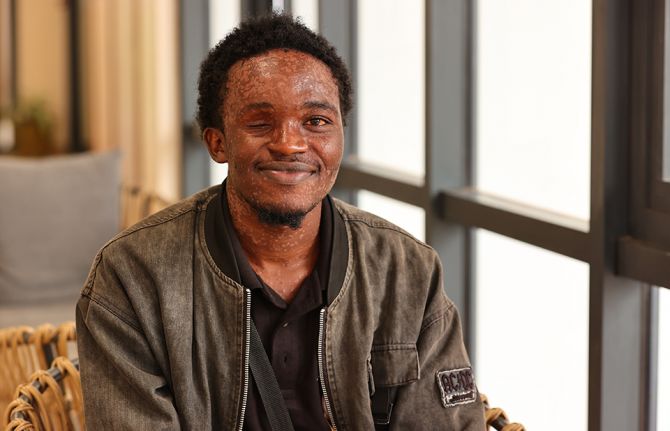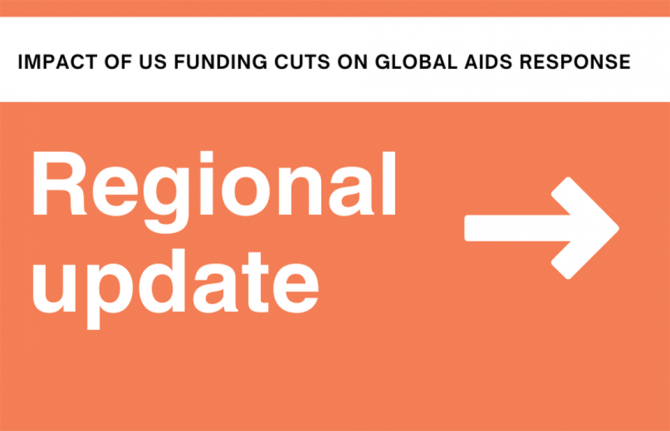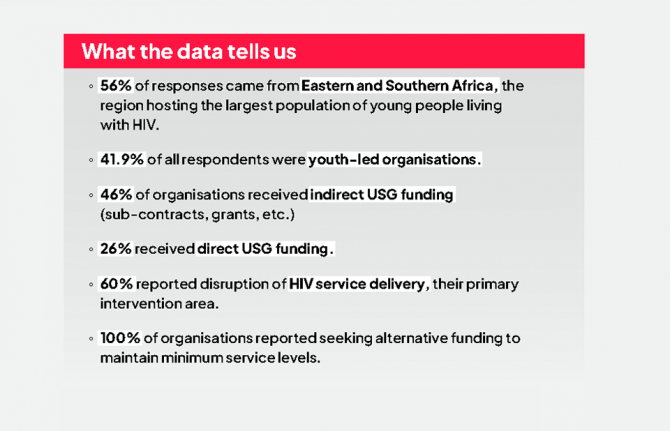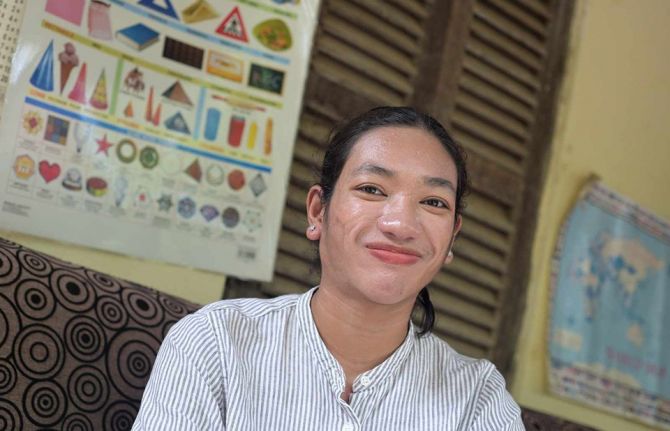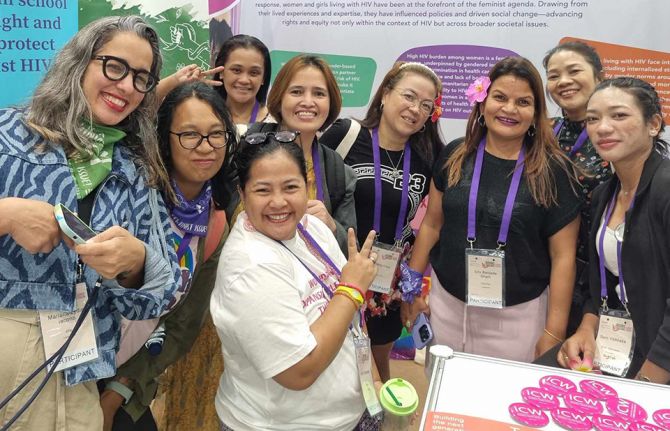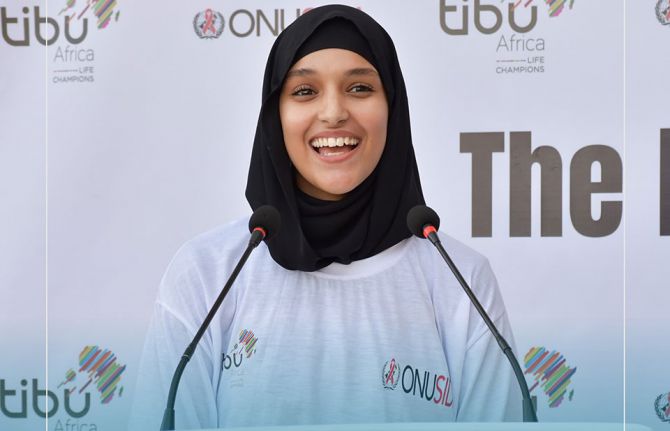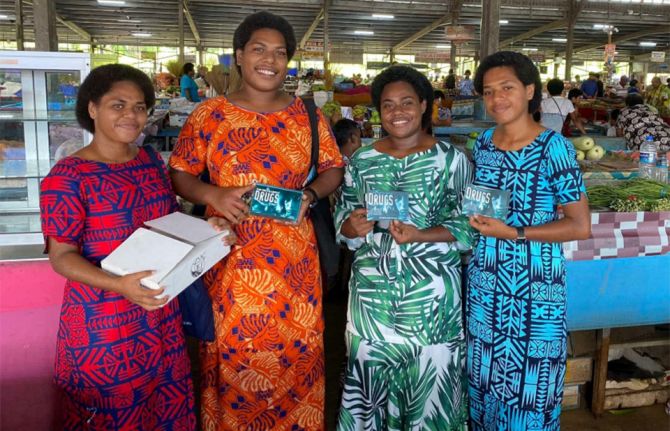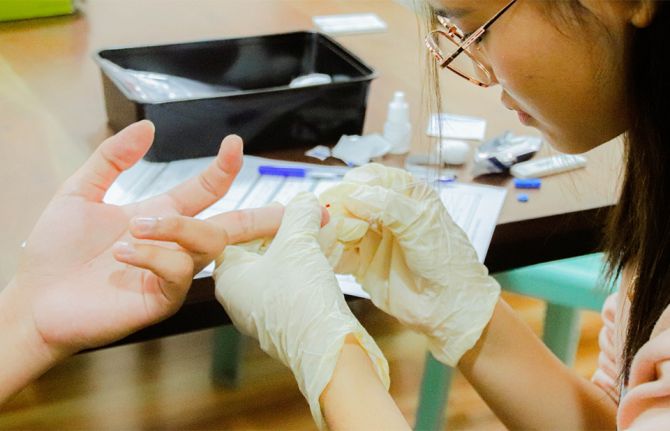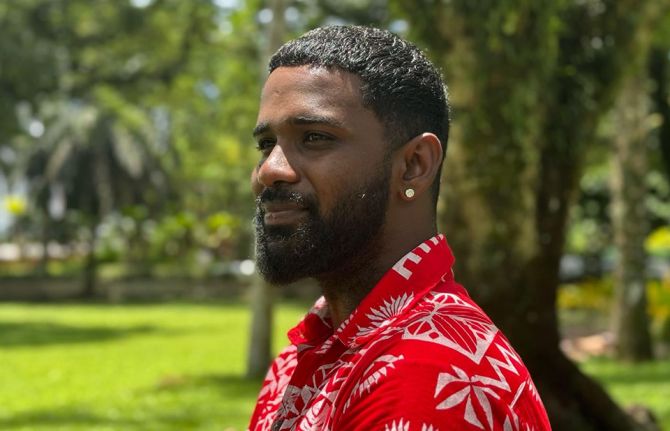
Feature Story
Progress in Mozambique's HIV response, but more focus needed on HIV prevention
05 September 2011
05 September 2011 05 September 2011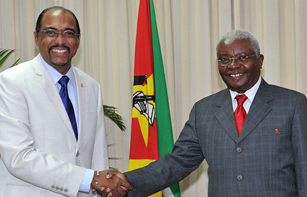
UNAIDS Executive Director Michel Sidibé (pictured left) with President Armando Emilio Guebuza of Mozambique.
In a meeting with Armando Emilio Guebuza, President of Mozambique, UNAIDS Executive Director Michel Sidibé commended the Government of Mozambique on progress in the national response to HIV, which has resulted in a reduction in new HIV infections and expanded access to antiretroviral treatment.
According to the latest estimates from UNAIDS, the rate of new HIV infections in Mozambique fell by more than 25% between 2001 and 2009. More than 200 000 people living with HIV in Mozambique were receiving life-saving treatment, care and support services at the end of 2010, according to government estimates.
“Commendable coordination between the Government of Mozambique, development partners and civil society has led to the scaling up of programmes for HIV prevention, treatment and care on the ground,” said the UNAIDS Executive Director.
Despite progress, Mozambique continues to have the second highest rate of new HIV infections in the world. In his meeting with the President, Mr Sidibé stressed the need for multi-faceted HIV prevention programmes based on local knowledge of the epidemic. Such programmes would require political commitment and leadership at the highest levels, he said.
In recent years, the Government of Mozambique has made improvements in the country’s primary health care system to meet the growing demand for HIV treatment, care and services. However, bottlenecks continue to hamper the AIDS response, including weak financial and supply management systems and an inadequate health workforce. Mr Sidibé called on President Guebuza and his Government to strengthen the national health care system and increase domestic resources for the HIV response.
Commendable coordination between the Government of Mozambique, development partners and civil society has led to the scaling up of programmes for HIV prevention, treatment and care on the ground
UNAIDS Executive Director Michel Sidibé
During the meeting, the UNAIDS Executive Director briefed the President on the launch of “Give AIDS the Red Card”—a campaign that uses the universal appeal of sports for advocacy around the UNAIDS vision of Zero new HIV infections, Zero discrimination, and Zero AIDS-related deaths. Mr Sidibé presented the President with a pledge of support for the “Red card” campaign signed by the heads of delegations from 47 countries participating in the 10th All-Africa Games in Mozambique.
Mr Sidibé informed the President of the planned appointment of up to 12 athletes as African Goodwill Ambassadors for the “Red Card” campaign across the continent. He urged the President to secure additional support for the “Red card” campaign from other world leaders at a UN General Assembly meeting in September 2011 and at the next African Union Commission Summit in Addis Ababa.
The meeting with the President Guebuza concluded Mr Sidibé's four-day official visit to Mozambique. While in Mozambique, the UNAIDS Executive Director also met the Prime Minister, other government officials, development partners and civil society groups to exchange views on opportunities and challenges in the national AIDS response.
A central concern raised by government officials and partners during the visit was the risk of stock-outs of antiretroviral drugs. “Drug stock-outs could potentially reverse the gains in Mozambique’s HIV treatment programme,” said Mr Sidibé. “Urgent steps must be taken to manage the risk of drug stock outs,” he added.
Related

Feature Story
Give AIDS the Red Card initiative launched at All-Africa Games in Mozambique
02 September 2011
02 September 2011 02 September 2011
Executive Director Michel Sidibé and Mozambique’s Minister of Youth and Sports H.E. Pedrito Fuleda Caetano with athletes from various African countries who signed the Give AIDS the Red Card initiative.
Credit: UNAIDS/A.Joe
UNAIDS Executive Director Michel Sidibé and Mozambique’s Minister of Youth and Sports H.E. Pedrito Fuleda Caetano launched the UNAIDS initiative Give AIDS the Red Card. The announcement was made on the eve of the 10th All-Africa Games, the continent’s largest multi-sports tournament bringing together more than 5 000 athletes.
“Reducing the numbers of new HIV infections is nowhere more imperative or urgent than in Africa,” said Mr Sidibé. “The All-Africa Games are a great occasion to raise awareness about intensifying efforts to reach UNAIDS’ vision of Zero new HIV infections, Zero discrimination and Zero AIDS-related deaths.”
The launch took place under the patronage of Dr. Aires Aly Bonifácio, Prime Minister of Mozambique. Attending the launch were former Mozambican President Joaquim Alberto Chissano as well as many leading athletes.
The UNAIDS Give AIDS the Red Card campaign aims to raise awareness and mobilize action to strengthen the response to HIV and accelerate progress across Africa. The campaign was introduced at the 2010 FIFA World Cup in South Africa with the support of 28 team captains. Captains of six teams at the 2011 FIFA Women’s World Cup in Germany also endorsed the initiative.
I urge all participants and fans across Africa watching the All-Africa Games to learn the facts about HIV prevention and give AIDS the Red Card
Minister of Youth and Sports of Mozambique, H.E. Pedrito Fuleda Caetano
At the Maputo event, heads of national delegations to the Games, including presidents of National Olympic Committees and Ministers of Sport from 47 participating countries, agreed to sign a pledge to support the Give AIDS the Red Card campaign for Zero new HIV infections, Zero discrimination, and Zero AIDS-related deaths.
By signing the pledge, each delegation is agreeing to set up a national plan of action on the Give AIDS the Red Card campaign in consultation with UNAIDS offices upon return to their respective countries.
The 2012 Africa Cup of Nations hosted by Equatorial Guinea and Gabon will be the next platform for pan-African mobilization of the initiative.
Youth participation critical to Mozambique’s AIDS response

UNAIDS Executive Director Michel Sidibé (left) and Mozambique’s Minister of Youth and Sports H.E. Pedrito Fuleda Caetano launched the UNAIDS initiative Give AIDS the Red Card.
Credit: UNAIDS/A.Joe
The importance of youth and sporting community participation in the response to AIDS was emphasized by the UNAIDS Executive Director during his meeting with Mozambique’s Minister of Youth and Sports, H.E. Pedrito Fuleda Caetano.
Mr Sidibé asked the Ministry to use the All-Africa Games to promote this initiative across all sports disciplines during the Games and beyond. Mr Sidibé emphasised that “sport events should be viewed as key platforms to link with other social movements to drive the prevention revolution including reducing vulnerability of women and girls, scaling-up HIV testing and counselling, reduction of multiple partnership and accelerating medical male circumcision.”
Sub-Saharan Africa continues to be the region most affected by HIV, with an estimated 22.5 million people living with HIV in the region representing 68% of the global total. However significant progress is being made in the region. In 22 countries, the HIV incidence rate has declined by more than 25% between 2001 and 2009.
External links
External links
Related

Feature Story
UNAIDS Executive Director commends the Government of Mozambique for its action on the 2011 Political Declaration on AIDS
01 September 2011
01 September 2011 01 September 2011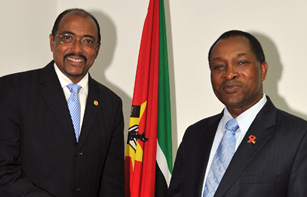
UNAIDS Executive Director Michel Sidibé with Prime Minister of Mozambique, H.E. Aires Aly Bonifácio
UNAIDS Executive Director Michel Sidibé met with Mozambique’s Prime Minister, H.E. Aires Aly Bonifácio as part of his four-day official visit to the country. During the meeting Mr Sidibé stressed the importance of high level political leadership, ownership and commitment to long-term predictable financing as a prerequisite for sustainable national AIDS response.
Mr. Sidibé applauded the Government’s commitment and rapid follow-up action to implement the Political Declaration adopted in June at the UN General Assembly High-Level Meeting on AIDS. “The urgency demonstrated by the Government of Mozambique to align their national strategies with the outcomes of the Political Declaration should be a model to other countries” said the Executive Director.
The urgency demonstrated by the Government of Mozambique to align their national strategies with the outcomes of the Political Declaration should be a model to other countries
UNAIDS Executive Director Michel Sidibé
Mr Sidibé underscored the importance of a prevention revolution to stop new HIV infections as well as the need to integrate the AIDS response with health and social development efforts. “Mozambique has the second highest rate of new adult HIV infections in the world. There is a need to accelerate prevention programmes,” said Mr Sidibé.
By the end of 2010, more than 200,000 people living with HIV were receiving life-saving treatment, care and support services in the country. The national programme to prevent new HIV infections in children has rapidly expanded with the opening of 909 sites in 2010 providing 67 percent coverage to pregnant women. However, Mozambique remains one of the top five countries in the world contributing to new HIV infections among children.
Expressing concern about the fact that 97 percent of Mozambique’s AIDS budget is generated from external sources, Mr Sidibé stressed the country’s need to increase domestic resources to ensure sustainable national AIDS responses in the coming years. “Mozambique needs to develop an innovative transitional plan for sustainable financing, which includes increased national budgets, private sector contribution and social health insurance,” said the Executive Director.
The Executive Director reiterated the commitment of the United Nations together with other key partners, including the Global Fund, PEPFAR and other bilateral partners to establishing a transparent and accountable mechanism to ensure the implementation of the third National Strategic Plan (PEN III 2010-2014) and accelerate the country’s progress towards MDG 6.
Related

Feature Story
New documentary film to stop violence against women and girls
31 August 2011
31 August 2011 31 August 2011
Credit: Sonke Gender Justice
A new documentary film following the lives of four people in Africa aims at challenging patriarchy, end men’s violence against women and promote gender equality. Produced by Sonke Gender Justice and MenEngage, the film titled A Way to Justice: Engaging Men for Women’s Rights and Gender Transformation focuses on gender, HIV and human rights issues.
“We need to build creative initiatives, to transform gender norms and break through cultural barriers to create new masculinities. By fostering women and men’s leadership for gender equality, we can succeed in creating safer, more just societies and stopping violence against women and girls.” said Michel Sidibé, Executive Director of UNAIDS.
We need to build creative initiatives, to transform gender norms and break through cultural barriers to create new masculinities
Michel Sidibé, Executive Director of UNAIDS
In the film individuals speak about the difficulties they confronted and transcended. David Tamba, a Sierra Leonean fleeing from civil war whose wife was gang-raped by rebels, began working with other men in refugee camps. “All men were viewed as bad men. But there were also men who were peaceful, who equally suffered, so the way to turn the story around was to start talking to our colleague men and go out and campaign for gender equality and empowerment of women,” said Mr Tamba.
Violence and the threat of violence hamper women and girls’ ability to adequately protect themselves from HIV infection and assert healthy decision making. The prevalence of forced first sex among adolescent girls younger than 15 years ranges between 11% and 45% globally. Adolescent girls and young women are among the most vulnerable groups to HIV infection.
Multimedia

Feature Story
UNAIDS Executive Director meets the Republic of Korea’s Minister of Foreign Affairs and Trade
30 August 2011
30 August 2011 30 August 2011
UNAIDS Executive Director Michel Sidibé (right) met with H.E. KIM Sung-Hwan, Minister of Foreign Affairs and Trade in the Republic of Korea, on 29 August in Seoul.
In an official meeting on 29 August with the Minister of Foreign Affairs and Trade in the Republic of Korea, H.E. KIM Sung-Hwan, UNAIDS Executive Director Michel Sidibé commended the Korean Government for its emerging global and regional role in the AIDS response.
“The Republic of Korea is increasingly showing leadership in the international response to both HIV and broader health and development goals,” said Mr Sidibé. “UNAIDS counts on countries like yours to accelerate a new wave of progress towards Zero new HIV infections, Zero discrimination and Zero AIDS-related deaths.”
The Republic of Korea has low HIV prevalence, with an estimated 7000 people living with HIV. Over the past decade, Korea has partnered with a number of international development agencies on a range of projects focused on AIDS, malaria and tuberculosis, particularly in sub-Saharan Africa. In his meeting with the Minister, Sidibé underscored that Korea could strengthen its contribution to global development by sharing technology and technical expertise with resource-poor countries.
The Republic of Korea is increasingly showing leadership in the international response to both HIV and broader health and development goals
UNAIDS Executive Director Michel Sidibé
During the meeting, Mr Sidibé thanked Korea for convening the 10th International Congress on AIDS in Asia and the Pacific (ICAAP) — a gathering this week in Busan of more than 2000 AIDS experts and activists from across the Asia Pacific region. He also noted that Korea will host a High Level Forum on Aid Effectiveness later this year.
The UNAIDS Executive Director expressed appreciation for the steps that the Korean government has taken in the past years to remove restrictions on entry, stay and residence that have blocked HIV-positive people from living and working in Korea. He noted that foreigners living with HIV are now eligible to obtain all types of visas to visit Korea. “Many people living with HIV from across the region participated in the ICAAP conference — a sign that the Republic of Korea, in practice, is taking this issue very seriously,” he said.
Mr Sidibé and Korea's Minister of Foreign Affairs said they looked forward to a strengthened partnership between UNAIDS and the Republic of Korea.

Feature Story
Pop band JYJ and UNAIDS make social media campaign "Love Always" a #1 hit
30 August 2011
30 August 2011 30 August 2011
JYJ do the Love Always sign on the launch date of the campaign.
Credit: Korean Herald/H.Park
Newly appointed UNAIDS Regional Goodwill Ambassadors, Korean pop group JYJ joined UNAIDS to launch a social media campaign, that has taken the Twitter world by storm.
Inspired by JYJ hit song lyrics, the “LoveAlways” campaign encouraged fans to download a specially designed Twibbon heart icon to their Twitter profile, and to tweet messages to break down HIV-related stigma and discrimination such as: “Be the one—stop HIV discrimination with JYJ and UNAIDS. Show you LoveAlways.”
The campaign ran from 26-30 August 2011, coinciding with the 10th International Congress on AIDS in Asia and the Pacific which was held in Busan, Republic of Korea and where JYJ were officially announced as UNAIDS Goodwill Ambassadors on the opening day.
At the launch of the campaign, the three members of JYJ—Jae joong, Yuchun and Junsu—all tweeted messages to their personal Twitter accounts, grabbing the interest of their collective 1.4 million followers on Twitter.
In the six days of the campaign, more than 32 500 fans showed their support via the Twibbon application; followers of the UNAIDS Twitter account nearly doubled.
We want to thank our fans for their great support for this campaign – they are showing that they Love Always and are ready to stop HIV discrimination
Jae joong, JYJ
So rapidly successful was the campaign that the Twibbon site itself both tweeted and posted on Facebook that the LoveAlways campaign was one of their “fastest-ever growing campaigns.” This message went out to some 1.1 million people on Facebook and Twitter, and LoveAlways has been featured on the Twibbon site since.
“The impact of this campaign with JYJ’s involvement has been just amazing,” said Steve Kraus, Director of the UNAIDS Regional Support Team for Asia and Pacific. “The reach JYJ have is extremely important in supporting our global goals of ending stigma and discrimination and we are delighted to have JYJ as our Goodwill Ambassadors for the region.”
The LoveAlways campaign has seen JYJ fans being creative and motivated through their tweets and messages. Many have pledged solid support to JYJ and UNAIDS to help eliminate HIV-related stigma and discrimination and encourage other young people to be more aware about HIV.
JYJ underlined their appreciation for their fan’s commitment: “We want to thank our fans for their great support for this campaign—they are showing that they LoveAlways and are ready to stop HIV discrimination. Their action makes us proud,” said band member Jae joong. “We hope our fans will continue to support us as we work on important AIDS issues with UNAIDS. This is a great start to our work and we are looking forward to more activities where we can speak out about AIDS,” he added.

Feature Story
ICAAP 2011 closes in Busan
30 August 2011
30 August 2011 30 August 2011
Credit: UNAIDS/Kim Doo Ho
Serving its theme "Different Voices, United Action", the 10th International Congress on AIDS in Asia and the Pacific (ICAAP) brought together voices and perspectives of more than 2 000 delegates from 65 countries towards the development of greater joint action for AIDS.
The biennial conference that took place in Busan, Republic of Korea, ended on 30 August after five days of symposia, skills-building workshops and satellite meetings – 131 sessions took place in total. Discussions entered on a number of central themes including: the evolving epidemiology of HIV in Asia and the Pacific; advances in basic and clinical services, meeting the challenges of reaching universal access, building and supporting leaders and advocated, engaging communities for effective responses and overcoming human rights, legal and policy barriers.
Recalling a number of key and emerging issues covered during the Congress, such as pervading stigma and discrimination in the region, access to affordable treatment and hepatitis C-HIV co-infection, Geoffrey Manthey of the UNAIDS Regional Support Team for Asia and the Pacific said, “These issues are real and need our immediate action. Although progress has been made, HIV is still a significant challenge for the region. Not only do we need measurable progress by the next ICAAP, we need to see a full commitment to non-discrimination against people living with and affected by HIV.”
The objectives of ICAAP10 were to create an opportunity to enhance AIDS responses to at the local, regional and global levels. The conference was cosponsored by the AIDS Society of Asia and the Pacific (ASAP) and UNAIDS.
Thanking participants for their participation, Local Organizing Committee co-chair, Chul-soo Kim encouraged everyone to work towards ‘Getting to Zero’, “ Let’s work even more, for a world free of HIV!”
ICAAP is the second largest forum for HIV in the world and encourages the release and discussion of scientific, programmatic and policy developments in the global response to AIDS. It offers a platform where different voices from diverse counterparts across the Asia and the Pacific region can assemble to deliver a united action.
Dr Subhasree Sai Raghavan of the International AIDS Society summed up some of the challenges that were highlighted during the congress, including TB-HIV and the implementation of new PMTCT guidelines, saying that “our region needs to do better — we have no excuse.”
All the speakers at the closing ceremony welcomed the fact that young people, especially from key populations at higher risk, were present in significant numbers — at least 95 delegates were under 25, as were most of the many Korean volunteers — and were taking an increasing leadership role through organizations such as YouthLEAD and Youth Voices Count, as well as through new social media initiatives.
HIV figures in Asia and the Pacific
In 2009, an estimated 4.9 million people in Asia were living with HIV, including 360 000 who became newly infected that year. The overall trends in this region hide important variation in the epidemics, both between and within countries. In many countries in the region, the epidemic is concentrated in a relatively small number of provinces. Injecting drug users, men who have sex with men, sex workers and their clients and transgender people have accounted for most of the new infections.
The HIV epidemic in the Pacific region is small, but the number of people living with HIV in this region nearly doubled between 2001 and 2009 — from 28 000 to 57 000. However, the number of people newly infected with HIV has begun to decline from 4700 in 2001 to 4500 in 2009. The HIV epidemics in the region are mainly driven by sexual transmission.

Feature Story
Stigma and discrimination against people living with HIV remains widespread in Asia and the Pacific, report shows
29 August 2011
29 August 2011 29 August 2011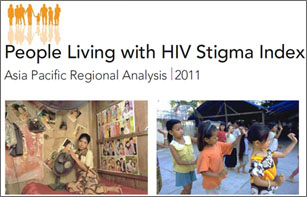
“HIV-related stigma is pervasive in the lives of people living with HIV. Stigma marks people as different and as disgraced... Stigma manifests in discriminatory and sometimes violent treatment of people living with HIV, their families and others affected by HIV.”
These are the opening words of the report entitled the People Living with HIV Stigma Index: Asia Pacific Regional Analysis launched on the fourth day of the 10th International Congress on AIDS in Asia and the Pacific (ICAAP), held in Busan, Republic of Korea.
Although data in the analysis often differs widely depending on country context, the analysis shows that stigma and discrimination remain rife across the region as a whole and are evidenced in many environments, including family and community life, as well as employment and health care.
For example, the study found that high percentages of people living with HIV had lost jobs or income in the last 12 months based on their HIV status: from 16% of those surveyed in Fiji to 50% in Cambodia. Elsewhere, people have experienced being refused the opportunity to work – from 9% in Bangladesh to 38% of those surveyed in the Philippines.
Stigma and discrimination based on HIV status, sexual orientation or lifestyle choice is unacceptable and hampers the AIDS response
Mr Michel Sidibe, UNAIDS Executive Director
“Stigma and discrimination based on HIV status, sexual orientation or lifestyle choice is unacceptable and hampers the AIDS response,” said Michel Sidibé, when sharing some of the findings at an earlier session of ICAAP. “The Stigma Index is an important initiative to increase the evidence base that will enable governments and civil society partners to work more effectively to reduce HIV-related stigma and discrimination,”
Nine-country analysis
The report is a synthesis of nine country studies conducted across the Asia and the Pacific region — Bangladesh, Cambodia, China, Fiji, Myanmar, Pakistan, Philippines, Sri Lanka, and Thailand — and provides the first large-scale regional comparison of standardized HIV-related stigma indicators.
Across the nine countries, discrimination in health care settings is documented as a recurring issue. Across countries in the analysis, data shows that many people living with HIV avoided clinics and hospitals for fear of being discriminated against because of their HIV-positive status. In health-care settings, confidentiality and involuntary testing for HIV were also cited as issues of concern.
The report shows discrimination is a reality for all ages. Up to 35% of people living with HIV in China under the age of 25, for example, reported that teachers were discriminatory to them based on their HIV status.
A pervading issue across the nine-country analysis was the incidence of verbal insults and threat felt by people living with HIV: in Myanmar up to 45% of those surveyed said they had experienced such discrimination.
Even when study respondents had not experienced direct discrimination, they had a generalized fear of discrimination and modified their behaviour accordingly, the report suggests.
The analysis examines how ‘self’ stigma is also an issue for people living with HIV. According to the country reports analysed, over a third of people living with HIV in Thailand decided not to marry. In Bangladesh this figure is even higher — to up to 77% — with 85% of people living with HIV in the country also deciding not to have any more children because of their sero status.
At the launch of the analysis, Positive Women’s Network youth coordinator Sangeeth Dolapihilla underlined how such stigma is common for people living with HIV. “The Stigma Index showed that people living with HIV have a lot of internal stigma — we feel we can’t have sex, we can’t have kids,” she said. “What is it going to take for our needs to be addressed, and get rid of this internalized stigma?”
Evidence for action
With the aim of documenting HIV-related stigma and discrimination and providing a mechanism to compare experiences in different settings and across time, the analysis findings will be used to inform national HIV responses. The studies can also act as a baseline against which progress on decreasing stigma and discrimination can be measured.
The report includes recommendations for countries, such as ensuring that stigma remedies are embedded in cohesive national HIV policy and programmatic responses, improving legal and policy responses to HIV-related stigma and discrimination and strengthening policy and practice to reduce HIV-related stigma and discrimination in health-care settings.
The Stigma Index initiative is a collaboration between the Global Network of People Living with HIV, the International Community of Women Living with HIV/AIDS, the International Planned Parenthood Federation, and UNAIDS.
The initiative is important not only in findings but also in process: the Stigma Index employs a wholly participatory approach where the research strategy and data collection is led by organizations of people living with HIV with support of domestic and international partners.
External links
External links
Publications

Feature Story
Secret lives, other voices: study explores sexuality, gender identity and HIV transmission risk in Fiji
28 August 2011
28 August 2011 28 August 2011
Fiji's President Ratu Epeli Nailitikau reads the report Secret lives, other voices at the launch.
Credit: UNAIDS/Kim
At the 10th International Congress on AIDS in Asia and the Pacific a new study called Secret lives, other voices was launched. It explores sexuality, gender identity and HIV transmission risk in Fiji, and represents the first research of its kind to be conducted since 1998 among men who have sex with men and transgender people in the country.
The launch was attended by Fiji's President Ratu Epeli Nailitikau.
With more than 200 respondents, the research project engaged staff members and volunteers from the AIDS Task Force of Fiji's Amithi Project and the AIDS Council of New South Wales.
Conceived with the aim to inform the HIV response and the development of community-based activities, the research was conducted by members of the community. Research staff included men who have sex with men and transgender people, from a variety of social and ethic background, who were involved in each stage of the process including planning, data collection, analysis and reporting.
The report found that men who have sex with men are at high risk of HIV in Fiji. Only 21.6% of respondents consistently used condoms during anal sex with a male or transgender partner in the previous six months. More than one in five reported never using them.
Although there are high levels of knowledge about HIV, with over 66% of respondents answering questions correctly about transmission, the knowledge is not translating to behaviour.
The study also explored transactional sex and found that two thirds of the respondents reported giving or receiving money, gifts or favours in return for sex, making this a common experience.
Of the respondents only 10% had taken an HIV test in the preceding 12 months and knew the results. Barriers to testing included confidentiality and privacy issues as well as respondents reporting judgmental attitudes by clinic staff.
With technical support from UNDP and ACON we were able to show that civil society has the capacity to complete in-depth research projects to a recognizably high standard
Niraj Singh, co-author of Secret lives, other voices
Many of the study participants had experienced some form of stigma and discrimination. About two thirds felt unsafe and uncomfortable expressing their sexuality or gender. About 57% reported experiencing verbal abuse and a third had been physically hurt in the previous six months.
The report recommends that HIV prevention and health interventions should be culturally appropriate and focused on reaching different groups within the men who have sex with men and transgender community, many of whom self identify in different ways. Access to HIV testing that is friendly should be scaled up and health care workers need training to best support the needs of men who have sex with men and transgender people, according to the authors.
In addition, the report recommends a concerted effort to challenge stigma and discrimination and increase psychosocial and support services. Men who have sex with men and transgender people are also encouraged to develop mobilizing skills to make sure their voices are heard.
"With technical support from UNDP and ACON we were able to show that civil society has the capacity to complete in-depth research projects to a recognizably high standard," said Niraj Singh, Project Manager with the AIDS Task force of Fiji and co-author of the report.
"The AIDS Task Force of Fiji has a very clear vision of the priorities leading from research to action. We now have a baseline which will help us to design and implement effective programmes to reach a diverse range of men who have sex with men and transgender people in Fiji. This study represents a valuable contribution to ongoing national and regional efforts to ensure that these communities are better served and better protected," he concluded.
The Secret lives, other voices project was funded by the United Nations Development Programme (UNDP).
External links
External links
Publications
Publications

Feature Story
Accelerating treatment 2.0 in Asia and the Pacific
28 August 2011
28 August 2011 28 August 2011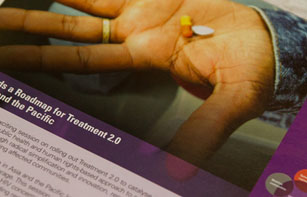
While the number of people living with HIV receiving antiretroviral therapy (ART) in Asia and Pacific almost tripled from 280 000 in 2006 to 739 000 in 2009, coverage remains low and only one in three people living with HIV had access to treatment in the region that year.
Early and equitable access to treatment in is hampered by stigma, discrimination and inaccessible service delivery. Limited use of rapid diagnostic and poor linkages between HIV testing and counseling and treatment results to delayed initiation of treatment. Funding constraints also hamper scale up and sustained access to ART.
With 4.9 million people living with HIV in the region, six courtiers account for over 90% of people eligible for treatment: China, India, Indonesia, Myanmar, Thailand and Viet Nam.
Treatment 2.0: the next phase of ART
Against this backdrop, the World Health Organization and UNAIDS Regional Support Team in Asia and Pacific, together with the Asia and Pacific Network of People Living with HIV Working Group (ANP +) organized a session to explore the critical components Treatment 2.0, an innovative approach to treatment on the second day of the 10th International Congress on AIDS in Asia and the Pacific.
In our region some people living with HIV do not even know that HIV can be treated
John Rock, of APN +
Treatment 2.0 is an initiative coordinated by UNAIDS and WHO to catalyze the next phase of HIV treatment scale-up, grounded in public health and human rights. The approach aims at universal and sustained access to antiretroviral treatment through radical simplification and innovation of treatment regimens, renewed commitment and resources, with a focus on decentralized delivery systems and greater involvement of communities.
“Substantial gains can be achieved through appropriate task-shifting and community-based delivery systems,” said Dr Iyanthi Abeyewickreme, HIV/STI Regional Advisor at WHO Regional Office for South-East Asia. “Decentralized services will help to leverage scarce resources to maximize their effect.”
Human and economic benefits
With 60% of people eligible for treatment in the region still not yet able to access it, need for scale up is urgent. There is ample evidence of the human and economic benefits of antiretroviral therapy for people living with HIV. In China, for example, it is estimated that the provision of free antiretroviral therapy has lead to a 64% drop in AIDS related mortality. A resent study has also shown that the risk of transmitting HIV to an uninfected sexual partner can be reduced by as much as 96%, when people living with HIV receive timely and effective antiretroviral therapy.
Funding is critical to take advantage of the multiple new opportunities and developments within the treatment arena.
Dr Bob Verbruggen, of the UNAIDS Regional Support Team in Asia and Pacific
John Rock, of APN +, stated that enhanced understanding of the life-saving benefits of treatment is needed: “In our region some people living with HIV do not even know that HIV can be treated,” he said. He also warned that treatment access needs to be safeguarded against terms of free trade agreements that could affect affordability and availability. Treatment scale up in the region necessitates increased and sustained financing. But experts at the Treatment 2.0 session underlined that investment now will ensure savings in the future.
What is needed to scale up treatment?
Dr Bob Verbruggen, of the UNAIDS Regional Support Team in Asia and Pacific said, “Funding is critical to take advantage of the multiple new opportunities and developments within the treatment arena. Implementing Treatment 2.0 will require important short-term funding from both international and domestic sources, but will yield huge savings in the medium and long term if we simultaneously invest in high-impact HIV prevention programmes.”
The session highlighted country experience and key steps to roll-out Treatment 2.0 in the Asia and Pacific region, and preliminary results from pilot countries such as Viet Nam. Some of the recommendations made included combined action of optimizing drug regimens, advancing point-of-care and other simplified platforms for diagnosis and monitoring, reducing costs, adapting delivery systems, and mobilizing communities and protecting human rights.

